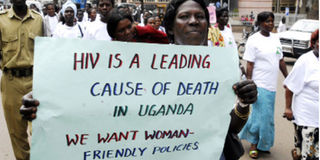25,000 babies born with HIV/Aids annually

Health officials have attributed HIV/Aids infection to complacency.
Kampala
As the world celebrates good results of an HIV/Aids drug trial conducted in Kenya and Uganda, the country once a role model in the fight against HIV/Aids, has for the last 10 years not made any progress in reducing the incidence of the disease.
The announcement early this week in the US that the use of certain ARVs among discordant partners had cut infection by 73 per cent is dampened by reports that the number of new infections every year is exceeding the number the government can treat. At the same time, donor money for the fight against the pandemic is dwindling.
Fresh alarm
Though infections in Uganda, which once had the highest, incidence rate in the world, dropped from 30 per cent in the early 1990s to around 7 per cent to date, Centre for Disease Control (CDC-Uganda), a bilateral partner within the US mission to Uganda has raised fresh alarm over increasing HIV/Aids infections.
Dr Wuhib Tadesse, the director CDC-Uganda at a news conference in Entebbe last week, said Uganda was the only country where HIV incidence has remained unchanged for more than 10 years. “In Uganda, for every person started on antiretroviral therapy, there are three new HIV infections and this is unsustainable,” Dr Tadesse said.
Dr Tadesse said there are no clear-cut answers to explain this trend, but added concerted efforts will be needed to stop new infections. “We are investigating what has caused this stagnation in the fight against HIV/Aids in Uganda and we are very concerned,” Dr Tadesse said. “But complacence could be part of the problem. Young people nowadays no longer see people dying; they see people on ARVs but getting children. We need to re-examine our strategies in the fight against HIV/Aids. Leaders at all levels are spending a lot of time in workshops than in the communities to sensitive the people and this must stop.”
According to Dr Tadesse, in the past 10 years, Uganda appears to have turned a corner in the opposite direction as more people continue to get infected. CDC figures show that there are 1.2 million Ugandans with the virus. However, according to Dr Tadesse, only about half of those who are in need of the life-saving drugs under the new treatment guidelines were receiving them by the end of last year. He said unless government deals with new infections through effective prevention strategies, achieving the universal treatment coverage of 80 per cent will be difficult.
Much of Uganda’s HIV/Aids programmes are being funded through the US President’s Emergency Plan for AIDS Relief (PEPFAR) and the Global Fund.
Dr Tadesse said under PEPFAR, Uganda has received over $1.2 billion between 2004-2010. Globally, as of September 2010, PEPFAR supported ART for 3.2 million people, care and support to 11 million people, counseling and testing to 33 million and provided $5.1 billion to Global Fund initiative.
However, with more than 110,000 new infections occurring every year, more funds will be required to help Uganda regain its reputation in the fight against HIV/Aids. But health experts at CDC-Uganda are concerned that if these new infections continue the way they are, it will be hard for Uganda government to cope with the cost of offering treatment to all. The number of Ugandans on ARVs has risen from 10,000 a decade ago to 200,000. But figures from the Uganda Aids Commission indicate that an extra 300,000 Ugandans in need of ARVs do not have access to the drugs because they cannot afford them.
In his response to the crisis, Dr Kihumuro Apuuli, the director general of the UAC, has since warned that the rising number of new infections will cause a critical challenge in the future, suggesting that more focus should be put on prevention and that the government should stop over relying on donor monies in its battle against the HIV/Aids pandemic.
A senior official in the Ministry of Health who preferred anonymity in order to speak freely, said even those on ARVs receive treatment largely as a result of American generosity. “We are guilty,” she said, adding: “As government, we have not taken prevention seriously. We have concentrated so much on treatment and care yet more Ugandans are getting infected each year and the number of those who need ARVs is increasing. It is time we reviewed the old-fashioned prevention because it has flopped. The few people in Uganda are using the “ABC”- abstain, be faithful and use condoms strategy”.




